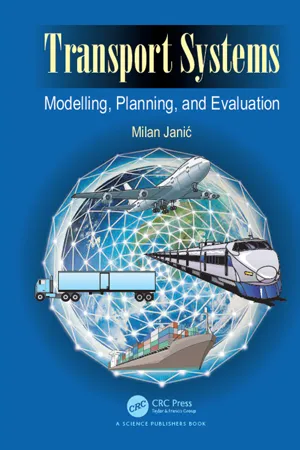
- 428 pages
- English
- ePUB (mobile friendly)
- Available on iOS & Android
About this book
The transport sector consists of different modes of transport, each serving a growing demand for transporting people and goods. This (growing) demand on the one hand, needs expanding the systems' capacity, and on the other hand, increasing the corresponding economic efficiency, effectiveness, and environmental and social friendliness. This implies development of a 'greener', i.e. a more sustainable transport sector.
The book describes the current and prospective state of the art analytical modelling, conceptual planning, and multi-criteria evaluation of the selected cases of transport systems operated by different transport modes such as road, rail, sea, air, and intermodal. As such, the book is unique in addressing these three important aspects of dealing with transport systems before implementation of their particular components means by the selected cases. It will be particularly useful for readers from the academia and the professionals from the transport sector.
Frequently asked questions
- Essential is ideal for learners and professionals who enjoy exploring a wide range of subjects. Access the Essential Library with 800,000+ trusted titles and best-sellers across business, personal growth, and the humanities. Includes unlimited reading time and Standard Read Aloud voice.
- Complete: Perfect for advanced learners and researchers needing full, unrestricted access. Unlock 1.4M+ books across hundreds of subjects, including academic and specialized titles. The Complete Plan also includes advanced features like Premium Read Aloud and Research Assistant.
Please note we cannot support devices running on iOS 13 and Android 7 or earlier. Learn more about using the app.
Information
CHAPTER
1
INTRODUCTION
Setting the Scene
CHAPTER
2
TRANSPORT SYSTEMS
Components & Concept of Performances
2.1 Introduction
(i) | The transport infrastructure of each mode consists of links and nodes, which, as mutually connected, constitute the infrastructure networks. These can be considered at different spatial scales such as urban, sub-urban, regional, national, international between countries, and intercontinental global. As far as the individual transport systems are concerned (i.e. use of private cars), the nodes are usually (regulated or non-regulated) intersections of urban and sub-urban streets, regional roads and interurban roads and highways. The segments of streets, roads and highways spreading between them are considered the links. In case of passenger mass transport systems, the nodes are the passenger bus, rail, stations, ports and airports, while the segments of roads and highways, rail lines, inland waterways, sea routes and airways, respectively, connecting them, are considered the links. In case of goods/freight mass transport systems, the nodes include freight road, rail, port, airport and intermodal terminals and the links are segments of the corresponding infrastructure lines connecting them. The main physical characteristics of the infrastructure nodes and links of transport systems operated by all modes are their specific design standards, size and spatial layout and position, i.e. location in the wider geographical area. The design standards generally provide compatibility of their use by both users and suppliers of transport services, including interoperability. The size and spatial layout depend on the current and prospective volumes and structure of demand to be accommodated on the one hand and the available land for settling down the given nodes and links, on the other. The position, i.e. location in the wider geographical area mainly refers to the maximum convenience of accessibility for users and at the same time compromising the existing non-transport activities as little as possible. All the above-mentioned characteristics are particularly relevant for the passenger and goods/freight terminals located within or very close to densely populated urban and sub-urban areas, as well as for the road and rail lines passing through them. |
(ii) | Rolling stock, i.e. transport vehicles, represent the mobile component of transport systems. They carry out transport services and thus facilitate mobility of persons and... |
Table of contents
- Cover
- Half Title
- Title Page
- Copyright Page
- Dedication
- Preface
- Acknowledgements
- Table of Contents
- Abbreviations
- About the Author
- 1. Introduction: Setting the Scene
- 2. Transport Systems: Components & Concept of Performances
- 3. Modelling Transport Systems—I: Operational, Economic, Environmental and Social Performances
- 4. Modelling Transport Systems—II: Influence of New Technologies on Performances
- 5. Modelling Transport Systems—III: Resilience
- 6. Planning Transport Systems: Infrastructure, Rolling Stock & Planning Process
- 7. Evaluation of Transport Systems: Methodology & Cases
- 8. Conclusions: Summary & Lessons Learnt
- Index